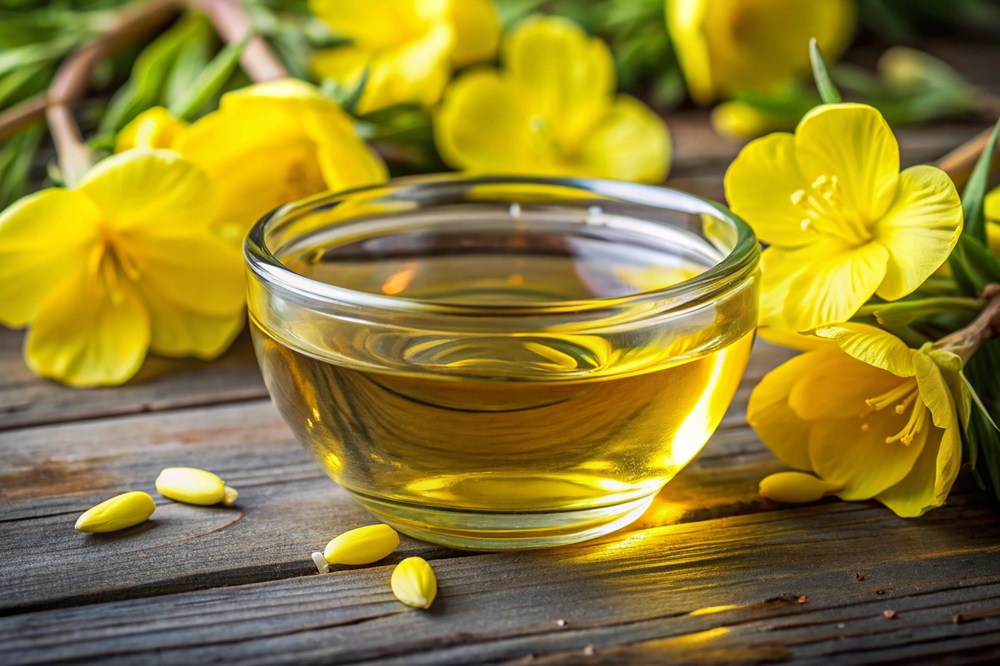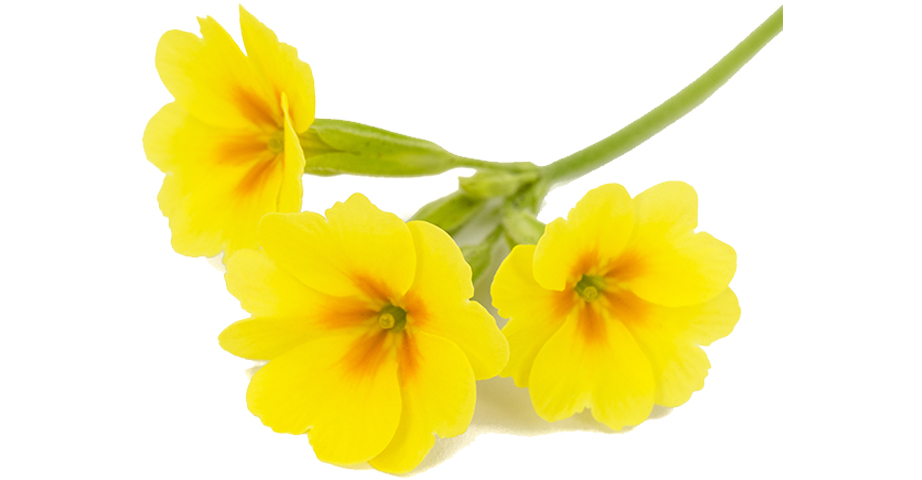Evening primrose oil - properties, uses, and precautions

Evening primrose oil is a product rich in unsaturated fatty acids that can support various bodily functions. It aids the nervous and immune systems and positively impacts the health of skin, hair, and nails. This versatile oil is commonly used as a food additive and as an ingredient in cosmetics and dietary supplements.
What is evening primrose good for? What compounds are found in cold-pressed oil from evening primrose seeds? What are the benefits of evening primrose oil? And how much does it cost?
Table of Contents
What is evening primrose oil?
Evening primrose belongs to the Onagraceae family, which includes around 120 different species. It is a flowering plant native to North America, but it now grows on other continents, including parts of the Southern Hemisphere and Europe.
The most commonly used plants from this family for oil production are:
- common evening primrose (Oenothera biennis)
- narrow-leaved evening primrose (Oenothera paradoxa)
Both species are characterized by single stems that can reach up to 150 cm in height. These plants feature distinctive yellow flowers that remain closed during the day and open in the evening. Interestingly, this blooming pattern is the reason behind the plant’s name. The English term "evening primrose" literally translates to "evening primrose flower," while in Polish, it’s often referred to as the "night candle."
Evening primrose is an edible plant, so both the root and young leaves can be consumed. However, the seeds - contained in elongated capsules - are the primary raw material for oil production due to their high concentration of valuable compounds.
Composition of evening primrose oil
Evening primrose oil is considered a nutrient-dense supplement. Research shows that it contains essential unsaturated fatty acids (EFAs), especially linoleic acid and gamma-linolenic acid (GLA). These omega-6 fatty acids cannot be synthesized by the body and must be supplied through diet or supplements.
In addition to linoleic acid and highly bioavailable GLA, evening primrose seed oil contains other fatty acids, including:
- oleic acid
- stearic acid
- palmitic acid
- eicosenoic acid
Due to its richness in unsaturated fatty acids, evening primrose oil should only be consumed cold and not used for cooking or heating.
The oil also delivers plant sterols - such as beta-sitosterol, campesterol, and sitostanol - as well as vitamin E and trace minerals like zinc, selenium, magnesium, and calcium.
Recommended evening primrose oil products and herbal extracts
Health benefits of evening primrose oil
Historically, evening primrose oil was used for bruises, wounds, and skin irritations, as well as digestive issues, sore throats, and hemorrhoids. Modern research highlights its potential benefits in improving blood lipid profiles, particularly in managing hyperlipidemia. Studies suggest that regular intake may help lower triglycerides and reduce LDL ("bad") cholesterol while increasing HDL ("good") cholesterol levels.
Cold-pressed evening primrose seed oil may also help lower blood pressure and support cognitive functions such as concentration, memory, and mental clarity. EFAs present in the oil may aid the immune system and promote detoxification processes by helping eliminate harmful substances and heavy metals from the body.
While evening primrose capsules are often marketed to women experiencing breast tenderness or hot flashes, current studies show only modest benefits for premenstrual syndrome (PMS) or menopause symptoms. Nonetheless, the oil may improve skin, hair, and nail health, which many women may find desirable.
Scientific data shows that evening primrose oil can nourish and hydrate the skin, reduce dryness, and prevent early signs of aging. It may also benefit people with eczema, psoriasis, or atopic dermatitis by soothing symptoms such as itching, swelling, and redness, thus helping minimize irritation. Additionally, the compounds in the oil can strengthen nails and improve scalp hydration. Evidence also suggests that cold-pressed evening primrose oil may reduce scalp itchiness, decrease dandruff frequency, and nourish the hair while reducing oiliness.
What is evening primrose oil used for?
Thanks to its valuable compounds and wide-ranging properties, evening primrose oil has become a popular product with various everyday applications.
High-quality oil from common evening primrose seeds is frequently used in skincare and cosmetology to support healthy skin, nails, and hair. It can also help address certain skin issues, making it a common ingredient in facial creams, body lotions, shampoos, scalp scrubs, hair oil treatments, and nail conditioners.
Additionally, evening primrose oil can be incorporated into the diet as a nutritious addition to salads, raw vegetable dishes, and homemade dressings. However, it should only be consumed cold, as heat can damage its delicate structure and diminish its health benefits and flavor.
Due to its numerous health-promoting properties, evening primrose oil is also widely available in dietary supplement form. You can find it in capsules or as a liquid, offering a convenient way to enrich your diet with beneficial compounds.
How to use evening primrose oil
In clinical studies, daily doses typically range from 1 to 5 grams. However, there is no universally recommended dosage. For this reason, it's essential to follow the manufacturer’s instructions and avoid exceeding the suggested intake to prevent unwanted side effects.
Evening primrose oil comes in various forms, so the right choice depends on individual needs and preferences. Regardless of the form, consistency is key—only regular use is likely to produce noticeable benefits.

Precautions and possible side effects
Evening primrose oil is generally considered safe. However, it should always be used according to the manufacturer’s guidelines or under medical supervision. Overconsumption may cause side effects such as diarrhea, stomach pain, headaches, nausea, or vomiting.
Most studies focus on short-term use, so due to limited data on long-term effects, extended use is not currently recommended.
Evening primrose oil is not suitable for everyone. Individuals taking blood-thinning medications should avoid it, as it may increase the risk of bleeding. Likewise, people with epilepsy or clotting disorders should not use it due to potential interactions and complications. If you're on any long-term medications, consult your doctor before starting evening primrose oil supplementation.
Best evening primrose oil - OstroVit
If you're considering evening primrose oil capsules, pay attention to the concentration of active ingredients, particularly the amounts of linoleic and gamma-linolenic acids. Choose supplements that clearly state these values.
A great option is OstroVit Evening Primrose Oil 60 Capsules, known for its high quality, affordability, and efficiency. The formula is clean and straightforward, providing beneficial fatty acids and vitamin E to support your daily nutritional needs.
Evening primrose oil - effects and summary
Evening primrose oil is derived from the seeds of a plant in the Onagraceae family and is rich in polyunsaturated fatty acids, especially linoleic acid and GLA (gamma-linolenic acid). Its valuable composition contributes to a range of potential health benefits, such as lowering blood pressure and supporting natural skincare. It may also enhance lipid profiles and improve the condition of hair and nails. Cold-pressed evening primrose seed oil has found widespread use in cosmetics, foods, and dietary supplements alike.
Bibliography:
- https://pubmed.ncbi.nlm.nih.gov/31497576/
- https://pubmed.ncbi.nlm.nih.gov/34200727//
- https://pubmed.ncbi.nlm.nih.gov/32441049/
- http://aestheticcosmetology.com/wp-content/uploads/2019/02/ke2015.4-2.pdf
- https://www.czytelniamedyczna.pl/7140,wielokierunkowe-dzialanie-oleju-z-wiesiolka-na-organizm.html
Data ostatniej aktualizacji: 17.02.2025

